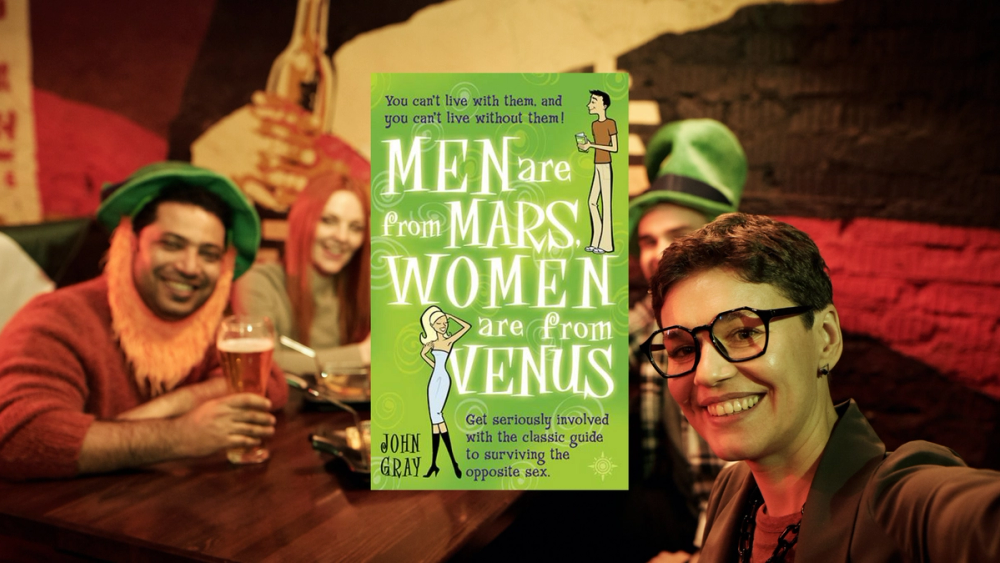Men Are from Mars, Women Are from Venus by John Gray

John Gray’s guide to relationships draws upon his years of experience as a relationship coach and marriage counselor, and despite having been written almost thirty years ago remains a modern classic today. The book in about 300 pages packs interesting insights into the dynamics of heterosexual relationships working up from the fundamental presupposition that men and women are different – so different in fact, that they might as well be from different planets. It is claimed that the friction between the sexes is a consequence of the failure to recognize our inherent differences and the insistence that men and women are the same beneath their superficial physiology. Relationships inadvertently fall prey to conflict, lose their charm or come to an end entirely just because we haven’t been socialized to view our words and actions from any perspective but that of our sex.
John Gray lays out the myriad of ways that men and women are distinct - from the way they think and behave, to how they show love differently, have different emotional needs, communicate differently, handle stress differently, and are motivated by different things.
Men are problem solvers that are more straightforward in their speech and like to retreat to their ‘caves’ when stressed and need an escape. They’re like ‘rubber bands’ that need independent time for themselves before they swing back to their women for intimacy and love. They prefer to be looked at with admiration and trust by their female counterpart and are motivated most when they are needed and made to feel like ‘the knight in shining armor for their women.
Women being from Venus, are different – more indirect in their speech, trying to get their message across without explicit communication. They tend to require that their man listens to them when they’re stressed and need to vent, without invalidating their feelings by offering unsolicited solutions. Women are like ‘waves’ that rise and fall in their ability to give love and need to be supported through their troughs by their male companions. Women are most motivated when they feel loved and cherished and are always looking for ways to support and improve their men.
The book has a full few pages dedicated to a ‘Martian/Venusian Phrase Dictionary’ where common daily phrases used by men and women are listed and their unintended connotations that the opposite sex hears. An entire chapter explains John Gray’s self-founded ‘Love Letter’ technique when verbal communication is difficult and can exacerbate conflict.
Despite being rather reductive and simplistic in its generalizations of men and women, I found myself nodding through many of the paragraphs in Chapter 8 where John Gray described the six different kinds of love that men and women each primarily need. I also resonated with the ideas in Chapter 4 that lays out how we’re motivated in different ways to give more to our partners and our relationship. I’m led to believe that women reading the book might also relate to many of the ideas in the book from a female perspective and that these concepts must have a kernel of truth to them even if not strictly scientific.
-Men Are From Mars, Women Are From Venus is not particularly sophisticated in its approach neither does it claim to draw its notions from science or empirical data. It is rather a compilation of the author’s own experiences and observations over his career as a relationship coach and consultant. Broad generalizations are drawn among men and women as the author admits in the preface, and analogies and anecdotes are used often to reinforce the claims made.
It was a fairly easy read and took not more than a couple of days to complete. The book is nearly three decades old but I struggle to think whether the author’s approach would be so appreciated today – it isn’t very politically correct in our times to put men and women into separate boxes like this or to even imply that they’re different in any way. Despite this, I found the ideas in the book to have the potential to help struggling couples when applied with humility and realism and can help men and women better understand the opposite sex to sympathize and reciprocate more in their relationships. I’d rate this book a 7/10 and I believe it’s a good place to start reading relationship advice/self-help guides given the enormous popularity this book has sustained through decades.
Previous Article
The Almanack of Naval Ravikant by Eric JorgensonNext Article
The Marriage Clock by Zara Raheem